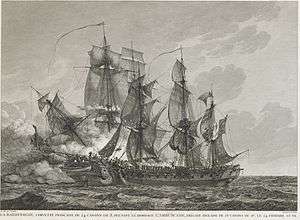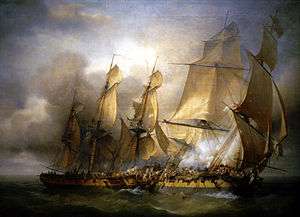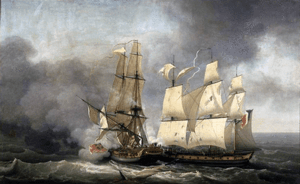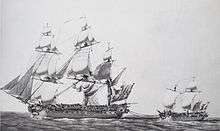Action of 14 December 1798
| Action of 14 December 1798 | |||||||
|---|---|---|---|---|---|---|---|
| Part of the French Revolutionary Wars | |||||||
 Pierre Ozanne's depiction | |||||||
| |||||||
| Belligerents | |||||||
|
|
| ||||||
| Commanders and leaders | |||||||
| Lieutenant de vaisseau Jean-Baptiste-Édmond Richer | Captain Henry Jenkins | ||||||
| Strength | |||||||
| 24-gun Bayonnaise | 32-gun HMS Ambuscade | ||||||
| Casualties and losses | |||||||
| 30 killed, 35 wounded[1] |
10 killed, 36 wounded[1] 1 frigate captured | ||||||
| ||||||
The Action of 14 December 1798 was a naval skirmish between the 32-gun British frigate HMS Ambuscade and the French 24-gun corvette Bayonnaise. Bayonnaise was vastly outgunned and outmanoeuvered, but was able to board and capture Ambuscade.
Events
On 14 December, as she sailed about 30 nm off Ré, Bayonnaise met the 32-gun frigate Ambuscade, cruising off Oléron under captain Henry Jenkins.
Prelude
Ambuscade was waiting to meet with HMS Stag and blockade the Gironde estuary. Bayonnaise was a 24-gun corvette laden with a strong crew augmented by a 40-soldier detachment from the régiment d’Alsace, under Army captain Nicolas Aimé.
At dawn, Ambuscade detected Bayonnaise and assumed she was Stag; Bayonnaise also detected Ambuscade, and, correctly assuming that she was a superior British warship, turned around to flee. From this manoeuver, Ambuscade understood that the sail was French and gave chase. Around noon, Ambuscade had closed in to cannon range, and the fight began.
Battle
After one hour, the British had gained the upper hand, damaging the hull and rigging of the corvette. As Ambuscade came off the stern of Bayonnaise in an attempt to rake her, one of the British frigate's starboard 12-pounders burst. The explosion destroyed Ambuscade's boats, left 13 of her sailors dead and wounded, and confused the crew. Bayonnaise attempted to take advantage of the confusion to escape south, but Ambuscade gave chase again and caught up with the corvette around 3 PM.
As the frigate sailed on the port side of the corvette on a parallel course, overtaking her, Bayonnaise backed sail and turned hard to port, ramming Ambuscade. The bowsprit of Bayonnaise cut down Ambuscade 's mizzen, wounding part of the crew standing on the poop deck, and entangling the two ships.
Both ships fired a last broadside and closed their gunports. Bayonnaise lost numerous men, and her captain, Richer, had an arm shot off. Nevertheless, French grapeshot and musketry fire cleared the decks of Ambuscade. Most of the British officers were wounded and taken below deck, leaving only ailing lieutenant Joseph Briggs in command. Having grappled the corvette to the frigate, the French used Bayonnaise's bowsprit to bridge the gap between the ships and climb onto the taller Ambuscade.
The French boarded and seized a light gun loaded with grapeshot, which they used to clear the forecastle of its defenders. The quarterdeck of Ambuscade suffered the explosion of a powder box, which destroyed the wheel and the stern boat. After a bloody, 30-minute melee, purser William Beaumont Murray, the last British officer still standing, surrendered Ambuscade. During the battle, Ambuscade had had 15 killed and 39 wounded, including Jenkins and his two lieutenants, and Bayonnaise 25 killed and 30 wounded, including Richer and his lieutenant.
Aftermath

Bayonnaise had lost almost all of her rigging, was leaking and had her rudder damaged. Ambuscade had lost her mizzen mast and sustained damage from explosions on board, but was otherwise intact and sea worthy. Ambuscade towed Bayonnaise to Pertuis d'Antioche and Rochefort. They arrived the next day.[2] Ambuscade was taken into French service as Embuscade.
Lieutenant de vaisseau Richer was promoted to capitaine de vaisseau (jumping three ranks), and the ensigns of Bayonnaise, Corbie, Frouin, Guigner, Kinzelbach and Potier de la Houssaye, were promoted to Lieutenant de vaisseau. Captain Jenkins was later court-martialled, accused of letting his ship, crewed by young sailors, be boarded by a stronger party, while he had a strong advantage at gunnery and manoeuvre. He was acquitted.[3]
The battle was used as a propaganda coup by the French government. Several paintings of the event were subsequently commissioned, notably a large painting by young Louis-Philippe Crépin which is now one of the main exhibits of the Musée national de la Marine in Paris.
-

Antoine Roux' depiction of the boarding
-

Jean François Hue's depiction of the boarding
-

Detail of Crépin's depiction
-

Pierre Ozanne's depiction of Ambuscade towing Bayonnaise back to harbour, with exaggerated proportions between the ships
-

Antoine Morel-Fatio's depiction, apparently inspired by Crépin's
-

Antoine Morel-Fatio's depiction of Bayonnaise taking her prize in tow.
Sources and references
| Wikimedia Commons has media related to Action of 14 December 1798. |
- 1 2 Histoire des marins français sous la République, de 1789 à 1803, Charles Rouvier, Arthus Bertrand , pp. 417
- ↑ It has been reported that Bayonnaise broke her tow line and arrived only days later under improvised rigging
- ↑ Naval History of Great Britain - Vol II
- Naval history of Great Britain, by William James
- (French) Combat de la Bayonnaise contre l'Ambuscade, 1798, Musée national de la Marine
- (French) 14 décembre 1798 : prise de la frégate anglaise HMS Ambuscade par la corvette française la Bayonnaise, by Philippe de Ladebat
- (French) 14 décembre 1798 Prise de la frégate anglaise HMS Ambuscade par la corvette française La Bayonnaise paintings of the event
- Combat de la fregate francaise la Bayonnaise centre la fregate anglaise l' Embuscade 14 decemb. 1798, National Maritime Museum
- Histoire des marins français sous la République, de 1789 à 1803, Charles Rouvier, Arthus Bertrand , pp. 416-419